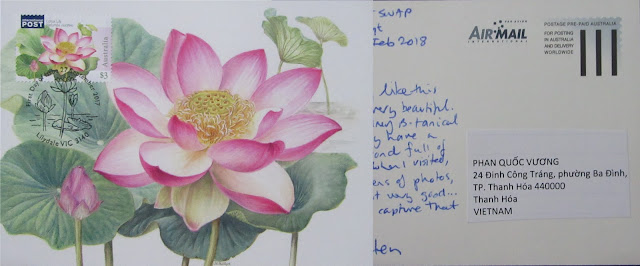This one is my first mail from Chile. So happy that I can take off another country from my missing list. And I was a bi surpris when i get it. My last Peru card took more than 6 months to arrive but the Chile one took only a month. They are from the same continent but not the same qualitty of service.
Thank you so much Misao for this suppor.
Rapa Nui National Park
UNESCO site
Date of Insscription: 1995
Rapa Nui National Park is a
protected Chilean wildlife area located in Easter Island, which concentrates
the legacy of the Rapa Nui culture. This culture displayed extraordinary
characteristics that are expressed in singular architecture and sculpture within
the Polynesian context. Easter Island, the most remote inhabited island on the
planet, is 3,700 kilometres from the coast of continental Chile and has an area
of 16,628 hectares while the World Heritage property occupies an area of
approximately seven thousand hectares, including four nearby islets.
The
island was colonized toward the end of the first millennium of the Christian
era by a small group of settlers from Eastern Polynesia, whose culture
manifested itself between the eleventh and seventeenth centuries in great works
such as the ahu –ceremonial
platforms- and carved moai -
colossal statues- representing ancestors. Rapa Nui National Park most prominent
attributes are the archaeological sites. It is estimated that there are
about 900 statues, more than 300 ceremonial platforms and thousands of
structures related to agriculture, funeral rites, housing and production, and
other types of activities. Prominent among the archaeological pieces are
the moai that
range in height from 2 m to 20 m and are for the most part carved
from the yellow–brown lava tuff, using simple picks (toki) made from hard
basalt and then lowered down the slopes into previously dug holes. There are
many kinds of them and of different sizes: those in the process of being carved,
those in the process of being moved to their final destinations –the ahu-, those being torn
down and erected. The quarries (Rano
Raraku and others) are invaluable evidence of the process of
their carving. The ahu vary
considerably in size and form; the most colossal is the Ahu Tongariki, with its
15 moai.
There are certain constant features, notably a raised rectangular platform of
large worked stones filled with rubble, a ramp often paved with rounded beach
pebbles, and levelled area in front of the platform. Also extremely valuable
are the rock art sites (pictographs and petroglyphs), which include a large
variety of styles, techniques and motifs. Other archaeological sites are the
caves, which also contain rock art. There is also a village of ceremonial
nature named Orongo which stands out because of its location and architecture.
While it has not attracted as much attention, the housing and productive
structures are of extreme interest.
According
to some studies, the depletion of natural resources had brought about an
ecological crisis and the decline of the ancient Rapa Nui society by the 16th century,
which led to decline and to the spiritual transformation in which these
megalithic monuments were destroyed. The original cult of the ancestor
was replaced by the cult of the man-bird, which has as exceptional testimony
the ceremonial village of Orongo, located at the Rano Kau volcano.
Fifty-four semi-subterranean stone-houses of elliptical floor plans
complement this sacred place, profusely decorated with petroglyphs alluding to
both the man-bird and fertility. This cult would see its end in the
middle of the nineteenth century.
Colonization,
the introduction of livestock, the confinement of the original inhabitants to
smaller areas, the dramatic effect of foreign diseases and, above all, slavery,
reduced the population of Rapa Nui to little more than a hundred.
Currently, the island is inhabited by descendants of the ancient Rapa Nui
as well as immigrants from diverse backgrounds, accounting for a significant
mixed population.
Critère (i): Rapa Nui National Park
contains one of the most remarkable cultural phenomena in the world. An
artistic and architectural tradition of great power and imagination was
developed by a society that was completely isolated from external cultural
influences of any kind for over a millennium.
Criterion (iii): Rapa Nui, the indigenous
name of Easter Island, bears witness to a unique cultural phenomenon. A society
of Polynesian origin that settled there c. A.D. 300 established a powerful,
imaginative and original tradition of monumental sculpture and architecture,
free from any external influence. From the 10th to
the 16th century this society built shrines and
erected enormous stone figures known as moai,
which created an unrivalled landscape that continues to fascinate people
throughout the world.
Criterion (v): Rapa Nui National Park is a
testimony to the undeniably unique character of a culture that suffered a
debacle as a result of an ecological crisis followed by the irruption from the
outside world. The substantial remains of this culture blend with their natural
surroundings to create an unparalleled cultural landscape.
Source: UNESCO.ORG

















































